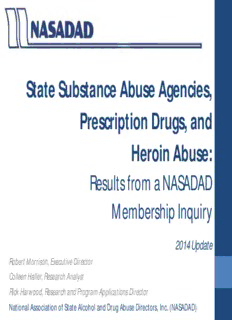
State Substance Abuse Agencies, Prescription Drugs, and Heroin Abuse PDF
Preview State Substance Abuse Agencies, Prescription Drugs, and Heroin Abuse
State Substance Abuse Agencies, Prescription Drugs, and Heroin Abuse: Results from a NASADAD Membership Inquiry s 2014 Update Robert Morrison, Executive Director Colleen Haller, Research Analyst Rick Harwood, Research and Program Applications Director National Association of State Alcohol and Drug Abuse Directors, Inc. (NASADAD) Prescription Drug Abuse (2012-2014): Overview of Findings • SSAs consider prescription drug abuse to be a very important issue. • Treatment systems have seen a 5-fold increase since 2001 (TEDS 2014). • States are doing a lot to address the problem: • Convened task forces. • Enacted legislation (e.g., focus on demand, focus on prescriber, focus on supply). • Provided education to prescribers, pharmacists, consumers, and the general public. 2 Heroin Abuse (2014): Overview of Findings • SSAs also consider heroin abuse to be a very important issue. • A majority of States have seen an increase in treatment admissions for heroin in the last 2 years. • Recent State efforts on heroin: • Expanded medication-assisted treatment (MAT). • Expanded access to naloxone/overdose prevention. • Provided education to general public. 3 Federal Agency Actions and Influences • Office of National Drug Control Policy (ONDCP) • Issued 2011 Prescription Drug Abuse Prevention Plan that promoted the following principles: • Education • Monitoring • Proper medication disposal • Enforcement • Various State substance abuse agencies incorporated some if not all principles into their own State plans. • Centers for Disease Control (CDC) • Collects epidemiological data on overdose deaths and other trends. • Coordinates with State health officials, NASADAD, and others. • Substance Abuse and Mental Health Services Administration (SAMHSA) • Maintains key prevention portfolio through the Strategic Prevention Framework and Partnerships for Success Grants. 4 • Provides training through the Providers’ Clinical Support System for Opioid Therapies. • Manages the Substance Abuse Prevention and Treatment Block Grant. 2014 Membership Inquiry: An Update • Original 2012 inquiry focused on SSA efforts on prescription drug abuse. • 2014 inquiry was updated and expanded to include prescription drug abuse, heroin, and opioid overdose. • Web-based survey was conducted March-April 2014. • Invited State Directors, Treatment Leads (NTNs), and Prevention Leads (NPNs) to participate. • Analysis includes 46 States and the District of Columbia (N= 47 States, 92% of States). 5 Background Data: Prescription Drug Abuse and Heroin 6 Drug Poisoning is the Leading Cause of Death from Injury in 30 States (CDC 2011) • Drug overdose rates vary across States. • Primary drug of abuse also varies widely across States and localities. • SSA programs and initiatives reflect the needs of that particular State, rather than national trends. Opioid Analgesics Involved in More Than 40% of Drug Poisoning Deaths in 2008 (CDC 2011) Number of drug poisoning deaths involving opioid analgesics and other drugs: United States, 1999–2008 Trends in Emergency Department Visits Involving Misuse or Abuse of Prescription Opioid Pain Relievers (DAWN 2013) Trends in Emergency Department (ED) Visits Involving the Nonmedical Use of Opioid Pain Relievers: 2004-2011 600,000 500,000 ED visits involving s t the misuse or abuse i 400,000 s i V D of opioid pain E 300,000 f o relievers rose 183% r e b 200,000 m from 2004 to 2011. u N 100,000 0 4 5 6 7 8 9 0 1 0 0 0 0 0 0 1 1 0 0 0 0 0 0 0 0 2 2 2 2 2 2 2 2 Source: 2011 SAMHSA 9 Drug Abuse Warning Network (DAWN) Prescription Drug Abuse: Understanding the Problem • Prescription drugs are 2nd most used illicit drug among persons 12 and older after marijuana (NSDUH 2013). • Opioid pain relievers are the most commonly misused prescription drug, making up 70% of misused prescription drugs during the past month (NSDUH 2013). • 10% of young adults aged 18-25 misused prescription drugs during the past month, second only to marijuana (NSDUH 2013). • Prescription drugs are 2nd most used illicit drug among youth in 12th grade after marijuana (Monitoring the Future 2014). 10
Description: